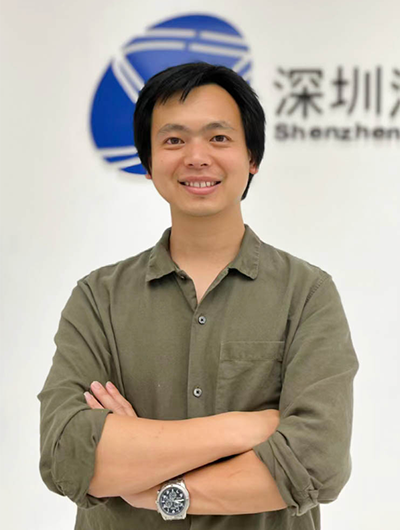
Innovation’s path may be lonely and dark, but it shines a light for those who follow!
Wang, Chao
王超
Institute of Systems and Physical Biology
Junior Principal Investigator
chaowang@szbl.ac.cn
Timeline
-
2023-Present
Shenzhen Bay Laboratory Junior Principal Investigator
-
2013-2023
The Scripps Research Institute Postdoc, Staff Scientist, Senior Staff Scientist
-
2007-2012
Institute of Biophysics Chinese Academy of Science. Ph.D.
-
2003-2007
Xiamen University B.Sc.
Research Areas
Dr. Francis Crick wrote in Nature, 1970, “The central dogma of molecular biology deals with the detailed residue-by-residue transfer of sequential information.” The overarching goal of Wang lab is to use variation in human genomics and phenomics to decode the residue-by-residue (and residue-to-residue) information flow through central dogma that shapes protein fold to drive function or dysfunction in the dynamic cellular context of human health and disease. We aim to develop both experimental and computational approaches to uncover the high-definition evolutionary trajectories for the form and function of the protein fold in the human population to enable an intelligent design of precision therapeutics.
highlights
Dr. Chao Wang has a long-standing interest and experience in studying protein homeostasis (proteostasis) in the cell and developing new therapeutic approaches for protein misfolding diseases. Major achievements in recent years include: (1) developed a new machine learning approach that uses a sparse collection of genetic variation in the human population to understand how each residue in the protein sequence contributes differentially to the complex mechanisms of disease or drug action. This approach helps identify new drug targets to guide precision disease management (Cell Reports 2018; Structure 2022). (2) revealed how the acetylation-related epigenetic program and Hsp70 chaperone system impact the sequence, structure, and function relationships of a lysosomal protein to modulate cellular cholesterol homeostasis and rescue neurodegenerative disease (Nat. Commun. 2019; Hum. Mol. Genet. 2020). (3) used machine learning and pharmacological activators of unfolded protein response to correct a complex genetic disease with lung and liver disorders caused by protein misfolding and aggregation (Cell Chemical Biology 2023). Dr. Chao Wang has received many rewards, including a travel award for the Lindau Nobel Laureate Meeting, the Ray Wu Prize, and fellowships from Alpha-1 Foundation and Cystic Fibrosis Research Foundation.
Honors
• 2016-2019 Postdoctoral research fellowship from Cystic Fibrosis Research Foundation
• 2014-2015 Postdoctoral research fellowship from Alpha-1 Foundation
• 2012 Ray Wu Prize
• 2012 Outstanding graduate of Beijing City
• 2012 Pollyanna Chu Yuet Wah Scholarship for Excellent Doctoral Student of Chinese Academy of Sciences
• 2011 Travel award for the 61st Lindau Nobel Laureate Meeting supported by Sino-German Center
Related News
1. Pharmacological management of disease by overcoming structural adversity: Cell Chemical Biology
2. Computational Approach Demonstrates Why Cystic Fibrosis Drugs Fall Short
3. Drilling for rare disease therapeutics
4. Drilling for Insight: Forecasting Phenotype from Genotype
5. Want to know which mutations are really risky? New Scripps Research method may help
Selected Publications
1. Sun, S.*, Wang, C.*, Zhao, P., Kline, G., Grandjean, J., Jiang, X., Labaudiniere, R., Wiseman, R.L., Kelly, J.W., and Balch, W.E. (2023) Capturing the Conversion of the Pathogenic Alpha-1-Antitrypsin Fold by ATF6 Enhanced Proteostasis. (*contributed equally). Cell Chemical Biology 30(1): 22-42, https://doi.org/10.1016/j.chembiol.2022.12.004.
· Highlighted by preview in Cell Chemical Biology. https://doi.org/10.1016/j.chembiol.2022.12.008.
2. Wang, C.*, Angles, F.*, & Balch, W.E. (2022) Triangulating variation in the population to define mechanisms for precision management of genetic disease. Structure. 30(8): 1190-1207. (*contributed equally). Link: https://doi.org/10.1016/j.str.2022.05.011.
· Highlighted in Genetic Engineering & Biotechnology News, Cystic Fibrosis News Today, ScienceDaily, Scripps News&Views etc.
3. Wang, C.*, Zhao, P.*, Sun, S.*, Teckman, J., & Balch, W.E. (2020) Leveraging Population Genomics for Individualized Correction of the Hallmarks of Alpha-1-Antitrypsin Deficiency (AATD). Chronic Obstr Pulm Dis. 7(3): 224-246. (*contributed equally). Link: https://doi.org/10.15326/jcopdf.7.3.2019.0167.
4. Wang, C. *, Scott, S.M.*, Sun, S., Zhao, P., Hutt, D.M., Shao, H., Gestwicki, J.E., & Balch, W.E. (2020) : Individualized Management of Genetic Diversity in Niemann-Pick C1 through Modulation of the Hsp70 Chaperone System. Hum. Mol. Genet. 29(1):1-19. (*contributed equally). Link: https://doi.org/10.1093/hmg/ddz215.
5. Wang, C., Scott, S.M., Subramanian, K., Loguercio, S., Zhao, P., Hutt, D.M., Farhat, N.Y., Porter, F.D., & Balch W.E. (2019) Quantitating the epigenetic transformation contributing to cholesterol homeostasis using Gaussian process. Nat. Commun. 10(1):5052. Link: https://doi.org/10.1038/s41467-019-12969-x.
6. Wang, C., Balch, W.E. (2018) Bridging Genomics to Phenomics at Atomic Resolution Using Variation Spatial Profiling. Cell Reports. 24(8): 2013-2028. Link: https://doi.org/10.1016/j.celrep.2018.07.059.
· Featured as Cover story. · Featured in spotlight section of Trends in Genetics. 34(11):821-822.
· Recommended by Faculty Opinions.
7. Wang, C., Bouchecareilh, M. & Balch, W. E. (2017) Measuring the Effect of Histone Deacetylase Inhibitors (HDACi) on the Secretion and Activity of Alpha1-Antitrypsin. Methods in Molecular Biology. 1639:185-193. Link: https://doi.org/10.1007/978-1-4939-7163-3_18.
8. Wang, C. & Balch, W. E. (2016) Managing the Adaptive Proteostatic Landscape: Restoring Resilience in Alpha-1 Antitrypsin Deficiency. in Alpha-1 Antitrypsin: Role in Health and Disease (Wanner, A. & Sandhaus, R. A., eds). Respir. Med. Link: https://doi.org/10.1007/978-3-319-23449-6_4.
9. Wang, C.*, Li, W.*, Ren, J., Fang, J., Ke, H., Gong, W., Feng, W. & Wang, C. C. (2013) Structural insights into the redox-regulated dynamic conformations of human protein disulfide isomerase. Antioxid Redox Signal. 19, 36-45. (*contributed equally). Link: https://doi.org/10.1089/ars.2012.4630.
10. Wang, C.*, Yu, J. *, Huo, L., Wang, L., Feng, W. & Wang, C. C. (2012) Human protein-disulfide isomerase is a redox-regulated chaperone activated by oxidation of domain a'. J Biol Chem. 287, 1139-49. (*contributed equally). Link: https://doi.org/10.1074/jbc.M111.303149.
11. Wang, C.*, Chen, S.*, Wang, X., Wang, L., Wallis, A. K., Freedman, R. B. & Wang, C. C. (2010) Plasticity of human protein disulfide isomerase: evidence for mobility around the X-linker region and its functional significance, J Biol Chem. 285, 26788-97. (*contributed equally). Link: https://doi.org/10.1074/jbc.M110.107839












